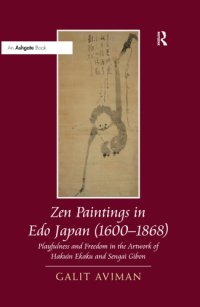
Ebook: Zen paintings in Edo Japan (1600-1868): playfulness and freedom in the artwork of Hakuin Ekaku and Sengai Gibon
Author: Aviman Galit, Hakuin, Sengai
- Tags: ART--Asian--Japanese, Calligraphy Japanese--Edo period, Calligraphy Japanese--History--Edo period 1600-1868, Ink painting Japanese--Edo period, Ink painting Japanese--Edo period 1600-1868, Zen calligraphy, Zen calligraphy--Japan, Zen painting, Zen painting--Japan, Electronic books, Criticism interpretation etc., History, Hakuin -- 1686-1769 -- Criticism and interpretation, Sengai -- 1751-1837 -- Criticism and interpretation, Ink painting Japanese -- Edo period 1600-1868, Calligraphy Japanese -- H
- Year: 2016
- Publisher: Taylor and Francis
- City: Japan
- Language: English
- epub
Cover; Title; Copyright; Contents; List of Illustrations; Acknowledgements; Introduction: Playing with Words and Images; 1 Evolution Towards Zen Paintings in the Edo Period; 2 An Independent Artistic Language; 3 Liberation From Rules; 4 Letting Go of Common Conceptions; 5 Emancipation from Social Conventions; 6 Humor as an Expression of Freedom; Conclusion: Ultimate Freedom; Bibliography; Index; Plates.;"In Zen Buddhism, the concept of freedom is of profound importance. And yet, until now there has been no in-depth study of the manifestation of this liberated attitude in the lives and artwork of Edo period Zen monk-painters. This book explores the playfulness and free-spirited attitude reflected in the artwork of two prominent Japanese Zen monk-painters: Hakuin Ekaku (1685-1768) and Sengai Gibon (1750-1837). The free attitude emanating from their paintings is one of the qualities which distinguish Edo period Zen paintings from those of earlier periods. These paintings are part of a Zen ink painting tradition that began following the importation of Zen Buddhism from China at the beginning of the Kamakura period (1185-1333). In this study, Aviman elaborates on the nature of this particular artistic expression and identifies its sources, focusing on the lives of the monk-painters and their artwork. The author applies a multifaceted approach, combining a holistic analysis of the paintings, i.e. as interrelated combination of text and image, with a contextualization of the works within the specific historical, art historical, cultural, social and political environments in which they were created."--Provided by publisher.
Download the book Zen paintings in Edo Japan (1600-1868): playfulness and freedom in the artwork of Hakuin Ekaku and Sengai Gibon for free or read online
Continue reading on any device:

Last viewed books
Related books
{related-news}
Comments (0)